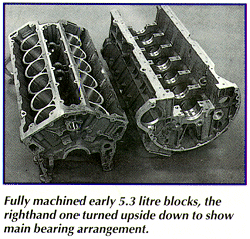|
|
 |
[ Main ] [ 1 ] [ 2 ]
[ 3 ] [ 4 ] [ 5 ] [ 6 ] [ 7 ] [ 8 ] [ 9 ] [ 10 ] [ 11 ] |
The fundamentals - combustion chamber and port designBy the time the first V12s were actually built the original concept had evolved somewhat and whilst the cylinder heads were clearly of XK parentage the inlet ports had shifted to a downdraft (Fig.1) position between the camshafts. This layout was not unique to Jaguar and almost seemed to be a fashion in the early 1960s with BRM and Ferrari using it in Formula 1 and also Ford going the same way for their advanced 4 valve, 4 cam, Indy V8. In those days the advantages of the modern, narrow angle, cylinder head design had not been recognised and relatively wide valve angles were common leaving little space between the heads of vee engines to find room for inlet porting. The downdraft layout with direct flow into the cylinder seemed to offer a better solution and whilst it was known that the complex Mercedes M196 engines which earlier did battle with the D Type were far from remarkable for their performance despite their high specification, this was generally considered to have been because the ports and valves were too large, rather than a failing of the downdraft head layout.Jaguar had to do a lot of work on the inlet port geometry to get the same specific power from the twin cam V12 as had been achieved with relative ease a decade or so before from the XK. A contributory factor was that the pronounced hemispherical combustion chamber which had worked so well on the long stroke XK was not nearly as efficient for a short stroke design like the V12. Only after bringing the inlet ports to an angle barely 40 degrees away from the valve axis instead of the original 60 degrees (Fig. 1) could 500 b.h.p. be exceeded and even then the torque band was unimpressive. Harry Mundys 1972 paper to the Institute of Mechanical Engineers explained all this in detail and concluded that the downdraft layout gave poor flow characteristics and reduced combustion efficiency because of indifferent charge turbulence. Once Keith Duckworth demonstrated the superiority of the narrow angle 4 valve layout when he created the Cosworth DFV F1 engine in 1966-7 the matter was settled and the downdraft port was finally dead and buried. Interestingly, Duckworths well-reasoned and innovative 4 valve design was prompted by his experiences with an earlier cylinder head layout which was destined to appear on the production V12. |

|
| [ Main ] [ 1 ] [ 2 ] [ 3 ] [ 4 ] [ 5 ] [ 6 ] [ 7 ] [ 8 ] [ 9 ] [ 10 ] [ 11 ] |
Email aj6engineering@ntlworld.com, Tel/Fax:- 0044 (0)1625 573556 |

